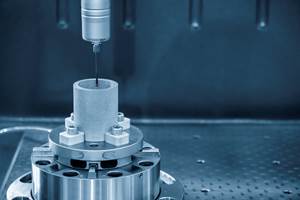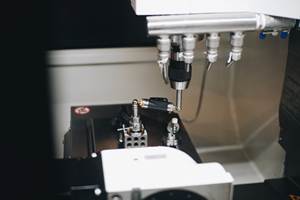Why QC Inspectors Should Consider Gaging Fixture Spring Rates
All fixtures for part gaging will have some amount of deflection or spring rate that can affect measurement accuracy. A better understanding of spring rate can enable quality control inspectors to detect and eliminate this possible error source.
Share





The fixturing on which an indicating instrument is mounted often leads to gaging-error questions such as “what is spring rate?” and “how do you test for it?” Most fixtures are made of several component parts and are, in essence, a variation of the well-known C-frame. If the user is aware of the common problems that can affect the use of the C-frame and other fixture designs, it can be easy to detect and eliminate possible error sources.
All substances, regardless of their hardness, have some degree of elasticity. Small as it may be, elasticity is a real and vital condition to be considered in a precision gaging setup. One must accept that the frame arrangement inevitably will deflect from even the slightest pressure. This deflection becomes significant when it is great enough to affect calibration.
In fact, this deflection is also known as Hooke’s Law, as it was this physicist who determined that the amount a spring stretches varies with the amount of force applied. While there may be no springs in a micrometer or bench stand, in reality, the frame of the gage actually acts like a spring.
There are a few solutions: Increase the spring rate (stiffness) of the gage frame to the point in which deflection is no longer great enough to affect calibration, reduce the spring rate of the indicating system until the deflection becomes insignificant, or compensate for the deflection. Deflection can be compensated for with an acceptable degree of reliability, although virtual elimination is the preferable alternative.
The size of the part to be gaged also figures heavily into whether spring rate will be a large or small problem. Large frames designed to accommodate sizeable workpieces are much more susceptible to a spring deflection error than frames designed for small pieces.
In the example of a snap gage or bench stand, what is spring rate? Spring rate is the relationship of load, which is expressed in pounds, to the deflection it causes, which is expressed in inches. The less a gage frame will deflect under a given load the greater its spring rate.
Generally, the spring rate of the gage frame should be at least 100 times that of the indicating system. Here is a basic example:
- A 1-pound weight on frame’s arm at the center line of the indicator's spindle deflects the arm 0.004 inch, as noted by a change in indicator reading with the work in place (see illustration).
- The force applied to the spindle of the indicator itself will cause the same change in indicator reading, which should be no greater than 0.01 pound (about 1.5 grams).
How is this force measured? The force can be determined by placing a reasonably precise weight scale under the indicator and noting the change in scale reading as the indicator is moved to produce a 0.004-inch change in indicator reading. In simple terms, the spring-rate ratio between gage frame and indicating system may be calculated by dividing the spring rate of the gage frame by the spring rate of the indicating system. The answer, or ratio, should be 100 (or more):1 to ensure that deflection will be insignificant and not affect calibration.
For most hand tools and smaller bench fixtures, designs that have been in use for decades have demonstrated that unless there is some unusual set of circumstances, deflection is a very small potential source of error. In this case, trying to increase a level of tolerance out of the gage can push it to the limit in which spring rate would have an effect. However, with special applications, such as large parts and long posts/arms on fixtures, it may be wise to take a look at spring rate and deflection as a source of error.
Related Content
How to Choose the Correct Fixed-Body Plug Gaging Solution
The two types of fixed-body plug gages are both accurate, fast and easy to use. Consider these factors when selecting one for your gaging application.
Read MoreThe Link Between CNC Process Control and Powertrain Warranties
Ever since inventing the touch-trigger probe in 1972, Sir David McMurtry and his company Renishaw have been focused on achieving process control over its own manufacturing operations. That journey has had sweeping consequences for manufacturing at large.
Read MoreParts and Programs: Setup for Success
Tips for program and work setups that can simplify adjustments and troubleshooting.
Read MoreBallbar Testing Benefits Low-Volume Manufacturing
Thanks to ballbar testing with a Renishaw QC20-W, the Autodesk Technology Centers now have more confidence in their machine tools.
Read MoreRead Next
Machine Shop MBA
Making Chips and 91ÊÓƵÍøÕ¾ÎÛ are teaming up for a new podcast series called Machine Shop MBA—designed to help manufacturers measure their success against the industry’s best. Through the lens of the Top Shops benchmarking program, the series explores the KPIs that set high-performing shops apart, from machine utilization and first-pass yield to employee engagement and revenue per employee.
Read MoreLast Chance! 2025 Top Shops Benchmarking Survey Still Open Through April 30
Don’t miss out! 91ÊÓƵÍøÕ¾ÎÛ's Top Shops Benchmarking Survey is still open — but not for long. This is your last chance to a receive free, customized benchmarking report that includes actionable feedback across several shopfloor and business metrics.
Read MoreAMRs Are Moving Into Manufacturing: 4 Considerations for Implementation
AMRs can provide a flexible, easy-to-use automation platform so long as manufacturers choose a suitable task and prepare their facilities.
Read More






















